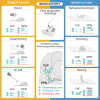Cell-type specific sensory and motor activity in the cuneiform nucleus and pedunculopontine nucleus in mice
- PMID: 40594670
- PMCID: PMC12217477
- DOI: 10.1038/s41598-025-05572-2
Cell-type specific sensory and motor activity in the cuneiform nucleus and pedunculopontine nucleus in mice
Abstract
The activity of neurotransmitter-based cell types in the cuneiform and pedunculopontine nuclei during locomotion, non-locomotor behaviors, and following sensory stimulation is not fully understood. Using fiber photometry in mice, we found cell-type specific responses to sensory stimuli. Glutamatergic and GABAergic cells responded to sound, visual looming, and air puffs, except for pedunculopontine GABAergic cells, which did not respond to visual looming. Cholinergic cells responded to air puffs. Air puffs triggered high-speed locomotion, whereas visual looming and sound stimuli evoked low-speed locomotion. During air puff-evoked locomotion, cuneiform glutamatergic neuron activity was higher than in trials without locomotion. In contrast, during locomotion evoked by visual looming or sound, activity in pedunculopontine glutamatergic neurons was higher than when no locomotion occurred. In the open-field arena, mice exhibited spontaneous low-speed locomotion during which activity increased in pedunculopontine glutamatergic cells. Activity also increased in a cell type-specific manner during grooming or rearing. Our study shows cell type-specific activity in the cuneiform or pedunculopontine nuclei during locomotion, non-locomotor behaviors, and following sensory stimulation. Sensory responsiveness likely has relevance in Parkinson's disease, where sensory circuits are increasingly targeted to improve walking.
© 2025. The Author(s).
Conflict of interest statement
Declarations. Competing interests: The authors declare no competing interests.
Figures







Similar articles
-
Treadmill interventions with partial body weight support in children under six years of age at risk of neuromotor delay.Cochrane Database Syst Rev. 2011 Dec 7;(12):CD009242. doi: 10.1002/14651858.CD009242.pub2. Cochrane Database Syst Rev. 2011. Update in: Cochrane Database Syst Rev. 2017 Jul 29;7:CD009242. doi: 10.1002/14651858.CD009242.pub3. PMID: 22161449 Updated.
-
Inhibitory basal ganglia nuclei differentially innervate pedunculopontine nucleus subpopulations and evoke differential motor and valence behaviors.Elife. 2025 Aug 20;13:RP102308. doi: 10.7554/eLife.102308. Elife. 2025. PMID: 40833252 Free PMC article.
-
Cholinergic, Glutamatergic, and GABAergic Neurons of the Pedunculopontine Tegmental Nucleus Have Distinct Effects on Sleep/Wake Behavior in Mice.J Neurosci. 2017 Feb 1;37(5):1352-1366. doi: 10.1523/JNEUROSCI.1405-16.2016. Epub 2016 Dec 30. J Neurosci. 2017. PMID: 28039375 Free PMC article.
-
Active body surface warming systems for preventing complications caused by inadvertent perioperative hypothermia in adults.Cochrane Database Syst Rev. 2016 Apr 21;4(4):CD009016. doi: 10.1002/14651858.CD009016.pub2. Cochrane Database Syst Rev. 2016. PMID: 27098439 Free PMC article.
-
GABAergic Retinal Ganglion Cells Projecting to the Superior Colliculus Mediate the Looming-Evoked Flight Response.Neurosci Bull. 2024 Dec;40(12):1886-1900. doi: 10.1007/s12264-024-01295-y. Epub 2024 Sep 16. Neurosci Bull. 2024. PMID: 39285154
References
-
- Arber, S. & Costa, R. M. Networking brainstem and basal ganglia circuits for movement. Nat. Rev. Neurosci.23, 342–360. 10.1038/s41583-022-00581-w (2022). - PubMed
-
- Leiras, R., Cregg, J. M. & Kiehn, O. Brainstem circuits for locomotion. Annu. Rev. Neurosci.10.1146/annurev-neuro-082321-025137 (2022). - PubMed
-
- Dubuc, R., Cabelguen, J. M. & Ryczko, D. Locomotor pattern generation and descending control: A historical perspective. J. Neurophysiol.130, 401–416. 10.1152/jn.00204.2023 (2023). - PubMed
MeSH terms
LinkOut - more resources
Full Text Sources

